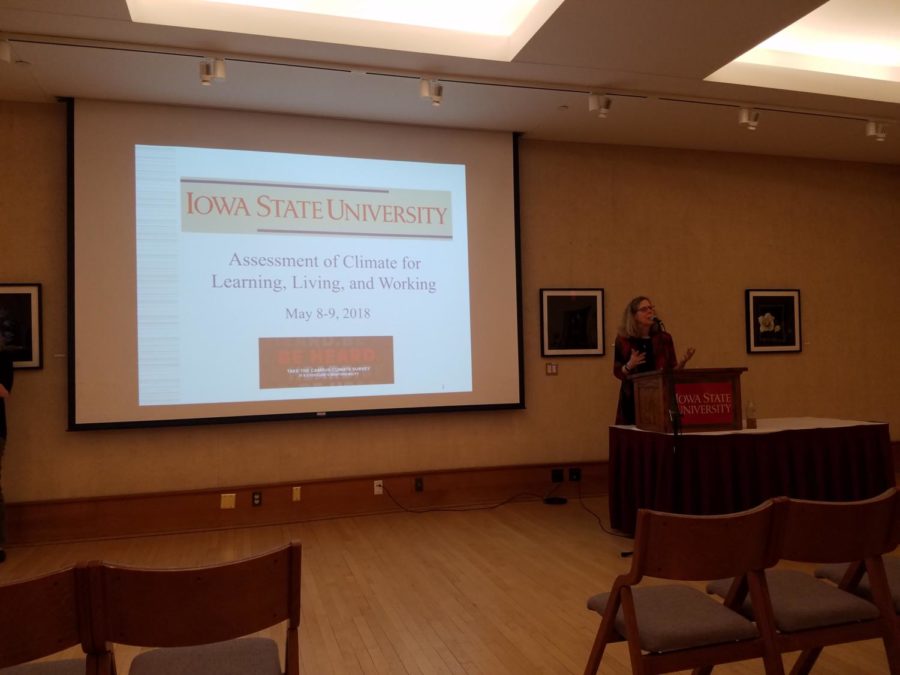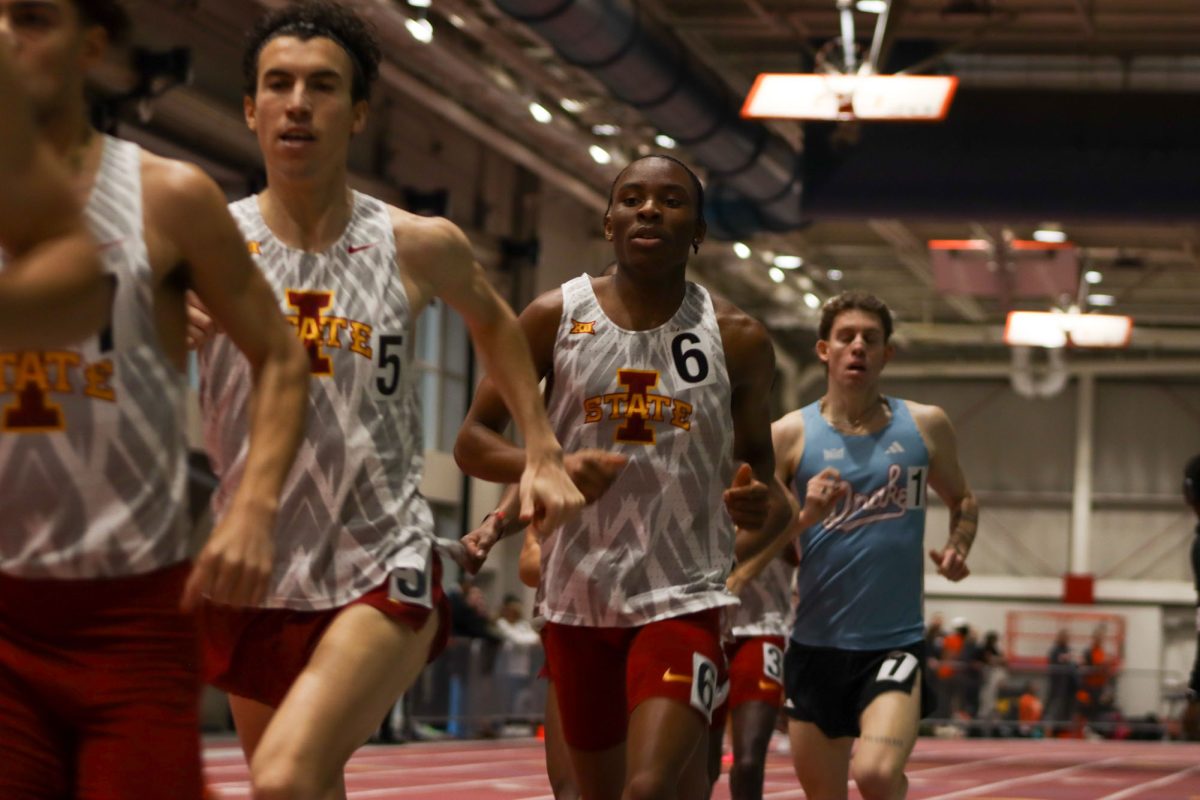- App Content
- App Content / News
- News
- News / Politics And Administration
- News / Politics And Administration / Campus
Campus Climate Survey Part Four: Perceptions of Campus Climate
President Wendy Wintersteen begins the discussion over the findings in the 2017 Campus Climate survey.
May 17, 2018
The full results of the fall 2017 campus climate survey, which was taken by 7,326 members of the Iowa State community and conducted by Rankin and Associates Consulting, were released on Wednesday, May 9.
The full results of the survey can be found on Iowa State’s campus climate website.
The Daily’s analysis of perceptions of campus climate has been divided into two sections: student perceptions and faculty and staff perceptions.
Student Perceptions of Campus Climate
According to the full report, significant differences exist by sexual identity, income and disability status.
Female undergraduate respondents were found to have greater perceived academic success than male undergraduate respondents.
Low income students had lower perceived academic success than their counterparts, as well as disabled students compared to their counterparts.
A majority of student respondents indicated positive perceptions of campus climate as well as positive interactions with faculty, staff and other students. For example, 75 percent of student respondents felt valued by Iowa State faculty, 74 percent felt valued by Iowa State staff and 53 percent felt valued by Iowa State senior administrators.
Significantly lower percentages of undergraduate student respondents, female respondents, transspectrum respondents, multiracial respondents, student respondents with a single disability, student respondents with multiple disabilities, U.S. citizen respondents, military service respondents, first-generation student respondents, no religious/spiritual affiliation respondents and off-campus housing respondents noted feeling valued compared with their colleagues.
Thirty-three percent of respondents had seriously considered leaving Iowa State. With regard to student status, 22 percent of undergraduate student respondents and 23 percent of Graduate/Veterinary Medicine student respondents had seriously considered leaving Iowa State.
Of the student respondents who considered leaving, 72 percent considered leaving in their first year as a student, 38 percent in their second year, 18 percent in their third year and nine percent in their fourth year.
Sixty-two percent of student respondents “strongly agreed” or “agreed” they had staff whom they perceived as role models.
Faculty and Staff Perceptions of Campus Climate
On hiring practices
Twenty-one percent of employee respondents indicated they had observed hiring practices at Iowa State University (e.g. hiring supervisor bias, search committee bias, lack of effort in diversifying recruiting pool) they perceived to be unjust.
Of those employee respondents who indicated they had observed discriminatory hiring at Iowa State, 28 percent noted it was based on nepotism/cronyism, 25 percent on gender/gender identity and 21 percent on ethnicity.
Here are some of the quotes from the survey people gave as complaints to hiring practices.
Ethnicity
“Iowa State University is focusing much more on hiring what ‘type’ of person they need rather than the best person for the job. A specific gender, race, sexual identity, etc. so to appear to be inclusive.”
“My supervisor has made comments about being anti-Muslim on campus, and she never hires people of color — she may interview and always seems to come up with a reason to hire the white person.”
Cronyism
“I have seen it multiple times, the hiring on this campus is rigged like 80% of the time. Friends get hired over qualified candidates, hiring committees manipulate the matrix to get the candidate they want, postings are extended passed the deadline (or reopened!) to allow referrals to apply.”
Gender
“Men get hired for certain jobs just because they are men. I have heard the committee members say things like ‘there’s no way a woman would want to spend all day doing that.’”
“I watched AGLS lose a promising professor, because she was not male and white. Animal Science went out of their way to make her feel unwanted, until she gave up and went into industry.”
“I have seen hiring managers say they did not want to hire a woman of a certain age, because she could start a family, and they didn’t want to have to accommodate maternity leave.”
“My friend (already working at ISU) was pregnant and interviewed for a more prominent job on campus. That supervisor (whom she knew and worked with on committees) told Rankin & Associates Consulting. . . that she should focus on her family right now, and that being a mom was more important than getting a promotion.”
“While serving on a faculty search committee, we were instructed to make offers to female candidates… We were also told that we could make multiple hires if the candidates were women, but not if they were men.”
Staff workload
Some respondents felt the work culture necessitated extreme work hours.
“There are expectations to be at work nights and weekends for certain events without getting any flex time. We keep getting told that this is expected of P&S staff.”
“Our positions are overworked by nature. 70-80 hour workweeks for most of the year, 60 hour workweeks during the lighter times, all schedules are dictated by others [rather] than us.”
“Because of email and social media, we are ‘expected’ to be accessible 24/7. Even when on vacation, we are on the proverbial clock. This leads to high burnout and tremendous fatigue.”
“I often work evenings, weekends, holidays, vacations, sick leave…because the work has to get done. I was working even while I was home for my father’s funeral.”
Opportunities
Sixty percent of staff respondents “strongly agreed” or “agreed” they were included in opportunities that would help their careers as much as others in similar positions.
A higher percentage of staff respondents with multiple disabilities than staff respondents with no disability (five percent) “strongly disagreed” they were included in opportunities that would help their careers as much as others in similar positions.
Seventy-six percent of staff respondents “strongly agreed” or “agreed” their supervisors provided adequate support for them to manage a work-life balance.
Fifty-eight percent of staff respondents “strongly agreed” or “agreed” a hierarchy existed within staff positions, which allowed some voices to be valued more than others.
Twenty-five percent of women staff respondents and 19 percent of men staff respondents “strongly agreed” a hierarchy existed within staff positions, which allowed some voices to be valued more than others. A higher percentage of white staff respondents (36 percent) than staff respondents of color (24 percent) “agreed” with the statement
One respondent said, “Other positions in our office are allowed to attend conferences outside of their job duties without taking leave. Others in our organization are not afforded the same treatment.”
Benefits
One respondent wrote, “Most of the people I know on campus remain here because of the benefits, as the wages are considerably lower than private business for the same skill sets.”
Another respondent shared, “The benefits here at ISU are ridiculously good. Salaries, at least in my department, are not very competitive with our counterparts in the private sector, but our benefits are much better.”
“Child care is not adequate. There is over a year-long wait list to get into an on-campus daycare. The Comfort Zone is a great option when you have a sick child, but it does not open until 8:30 and my first class starts at 8:00, thereby making it useless to me.”
Overall Atmosphere + Summary of Staff/Faculty Perceptions
Fifteen percent of LGBTQ faculty respondents and two percent of heterosexual faculty respondents “strongly disagreed” they would recommend Iowa State as a good place to work.
Twenty-seven percent (n = 198) of faculty respondents “strongly agreed” or “agreed” students prejudged their abilities based on their perception of their identity/background.
Thirty-three percent of respondents had seriously considered leaving Iowa State. With regard to employee position status, 54 percent of faculty respondents and 50 percent of staff respondents had seriously considered leaving Iowa State in the past year.
SUMMARY:
The results from this section suggest most faculty and staff respondents generally hold positive attitudes about Iowa State policies and processes.
With regard to discriminatory employment practices, 21 percent of faculty and staff respondents had observed unfair or unjust hiring, 10 percent had observed unfair or unjust disciplinary actions and 19 percent had observed unfair or unjust promotion, tenure, and/or reclassification.
Gender identity, ethnicity, age, position, philosophical views and nepotism/cronyism were the top perceived bases for the reported discriminatory employment practices.







